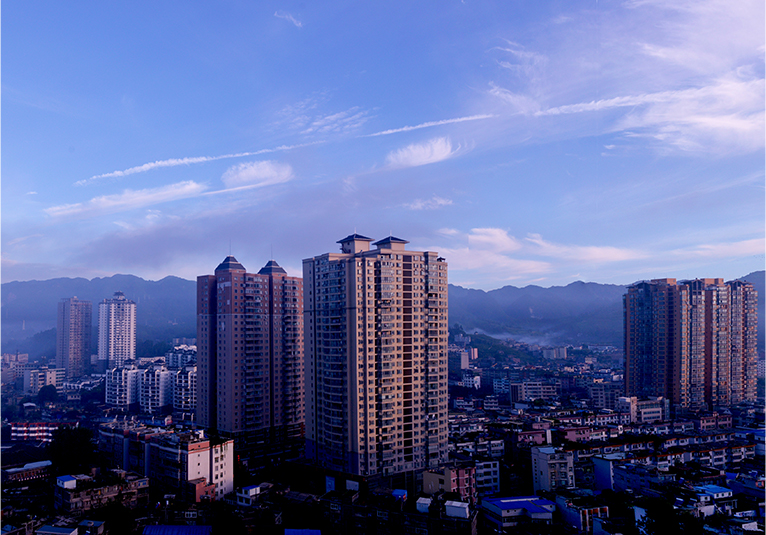- Profile Jurisdictions GOV DEPARTMENTS Cultures Travelling Educate
-
Zhenjin County is located in the southwestern part of central Guizhou Province, in the southern part of the Bijie Experimental Zone, situated in the triangular area where the Liuchong River and the Sanzha River, two tributaries of the upper reaches of the Wujiang River, converge. The highest elevation is 2,262 metres, the lowest is 861.5 metres, and the county seat is at an elevation of 1,310 metres. Annual precipitation averages 1,340.6 millimetres, with an average annual temperature of 14.1°C. Winters are mild, and summers are not excessively hot. The county covers a total area of 2,868 square kilometres, comprising 33 towns (sub-districts) and 578 villages (communities), home to 26 ethnic groups including Han, Miao, Yi, Bai, and Bouyei. By the end of 2024, the permanent population was 713,300. It is an important component of the ‘Qianzhong Economic Zone’ and a planned area of the ‘Bishuixing Energy and Resource-Rich Zone.’ It serves as a key node connecting the Bijie Experimental Zone with the Qianzhong Economic Zone, the Yunnan Central Economic Zone, and the Qianbei Economic Cooperation Zone. It is renowned as the ‘Hometown of Baozhen and the Cave Heaven of Zhenjin.’

Zhenjin has a long history, a rich cultural heritage, and stunning natural scenery. During the Qin Dynasty, it belonged to the Ba Commandery; during the Han Dynasty, it belonged to the Zangke Commandery. After the Jin Dynasty, the Yi people took control, and by the Tang Dynasty, it became Hui Prefecture. During the Song, Yuan, and Ming Dynasties, it was known as Pina; during the Qing Dynasty, it was Pingyuan Prefecture; and in the third year of the Republic of China, it was renamed Zhenjin. Notable historical figures such as Ding Baozhen, a prominent official of the late Qing Dynasty; Chen Zhanxi, the Minister of Mines; Ding Daoheng, a geologist; and Wang Xizhong, a renowned physician, all hailed from Zhenjin. The region is rich in ethnic culture and has a profound cultural heritage. The Miao ethnic group's Jumping Flower Hill, polyphonic love songs, the beautiful ‘Three-Eyed Flute,’ and the reed pipe dance; the Yi ethnic group's Torch Festival, the Bouyei ethnic group's love songs, and the ‘Nüxi’ performances of the Chuanqing people—these ethnic folk cultures are diverse and vibrant. The region is blessed with picturesque mountains and clear waters, offering breathtaking scenery. It is home to the national-level scenic area and world-class geological park known as the ‘First Cave Under Heaven’—Zhenjin Cave, renowned for its grandeur, uniqueness, comprehensiveness, and beauty. The cave is also celebrated for its extraordinary landscapes of ‘caves within caves, bridges over bridges, and water upon water,’ earning it the praise of renowned geomorphologist Williams as ‘a world-class karst landscape.’ It is also one of the first national-level ‘water scenic areas’ in China— —Zhenjin Grand Canyon, the Hongjiadu Hydropower Station, where the Western Development Initiative was launched, blending lake and mountain scenery, the Dongfeng Lake, a highland lake combining the wonders of the Three Gorges and the elegance of Guilin, the Caishen Temple, a rare and uniquely styled ancient building, and the Zhenjin Ancient City, one of Guizhou's ‘Ten New Landmarks.’ The county seat boasts 108 springs, 112 ancient temples, tombs, bridges, and pagodas, and a natural and cultural landscape that combines karst caves, lakes, gorges, and natural skylights with historical and cultural relics.

Zhenjin is rich in resources and has enormous development potential. The county has identified reserves of 26 types of minerals, including 10.7 billion tonnes of high-quality smokeless coal, accounting for over 20% of Guizhou's total reserves, earning it the title of ‘Southwest Coal Sea’; 1.49 billion tonnes of phosphate ore, accounting for 55.7% of Guizhou's total reserves; 19.1 billion cubic metres of marble, 20 million tonnes of barite, 15.6544 million tonnes of bauxite, and kaolinite reserves exceeding 15,000 tonnes with a whiteness value of over 90%. Other mineral resources are also extremely abundant. The county has four large and medium-sized reservoirs with a total storage capacity of approximately 6.5 billion cubic metres. It is the largest national base for the production, cultivation, and trade of bamboo mushrooms, with its fragrant red-stemmed bamboo mushrooms being hailed as the ‘Queen of Fungi.’ These mushrooms were once served as an important dish during Premier Zhou Enlai's reception of U.S. President Nixon and as one of the main courses at the Shanghai APEC Summit.
In recent years, Zhenjin County has been guided by Xi Jinping Thought on Socialism with Chinese Characteristics for a New Era, deeply studying and implementing the spirit of the 20th National Congress of the Communist Party of China, President Xi Jinping's important speech at the Guizhou Provincial Delegation, his important instructions on the work of the Bijie Experimental Zone, the spirit of the National People's Congress and the Chinese People's Political Consultative Conference, as well as relevant meetings at the provincial and municipal levels. It has conscientiously implemented the major decisions and plans of the central, provincial, and municipal governments, with poverty alleviation as the overarching priority for socio-economic development. Focusing on the main theme and strategic direction, it has prioritised stabilising growth, promoting reform, adjusting the economic structure, improving people's livelihoods, and preventing risks. The county's socio-economic development has shown a positive trend of steady progress and improvement.

In 2024, the county's gross domestic product (GDP) reached 27.12 billion yuan, representing a year-on-year increase of 4.2%. Among these, the primary industry contributed 5.419 billion yuan, up 3.4% year-on-year; the secondary industry contributed 8.808 billion yuan, up 5.5% year-on-year; and the tertiary industry contributed 12.893 billion yuan, up 3.8% year-on-year. The per capita disposable income of urban residents was 41,127 yuan, up 4.5% year-on-year. The per capita disposable income of rural residents was 15,426 yuan, up 7.5% year-on-year.

2025 is the final year of the 14th Five-Year Plan and a critical year for our county to accelerate the ‘strengthening industry and revitalising production, transforming and breaking through’ strategy. The overall requirements for government work are: to adhere to Xi Jinping Thought on Socialism with Chinese Characteristics for a New Era as the guiding principle, fully implement the spirit of the Third Plenary Session of the 20th Central Committee of the Communist Party of China, President Xi Jinping's inspection of Guizhou Province, and his important instructions and directives on Guizhou and Bijie's work, fully implement the decisions and deployments of the Provincial Party Committee, Municipal Party Committee, and County Party Committee at their respective plenary sessions, earnestly implement the arrangements made at the Central Economic Work Conference, the Provincial Party Committee Economic Work Conference, the Municipal Party Committee Economic Work Conference, and the County Party Committee Economic Work Conference, and thoroughly implement the spirit of State Council Document No. 2 [2022], State Council Document [2022] No. 65, adhere to the general principle of seeking progress while maintaining stability, fully and accurately implement the new development philosophy, focus on the ‘three major themes’ and the strategic positioning of ‘two zones, one model, and one base,’ fully leverage the ‘three major advantages,’ follow the work approach of ‘three major priorities’ and ‘six threes,’ closely align with the requirements of ‘one priority and two innovations,’ better balance high-quality development and high-level security, We will deeply implement project construction to promote investment, industrial upgrading to promote employment, urban-rural coordination to promote consumption, livelihood保障 to promote the ‘three senses,’ and risk prevention to promote governance. We will use phosphorus-coal integration to drive new industrialisation, production-sales integration to drive agricultural modernisation, urban-rural integration to drive new urbanisation, and scenic-urban integration to drive tourism industrialisation, striving to open up a new局面 of high-quality development for the entire county.
contact details
Tel:00-86-0857-7621153
Address:Zhenjin County Government Building, No. 5 Xinhua North Road, Wenten Street, Zhenjin County
Working hours:8:30 AM - 12:00 PM, 2:30 PM - 6:00 PM (Monday to Friday) Excluding public holidays
